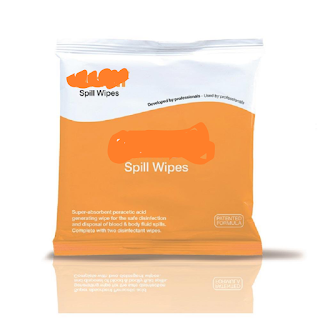Evaluation of the virucidal efficacy of disinfectant wipes
Background: The use of disinfectant wipes in hospitals is increasing over the last years. These wipes should be able to inactivate microorganisms including viruses on environmental surfaces and to prevent their transfer to clean areas. The European norm (EN) 16615:2015 describes a wiping process over four fields starting on the contaminated field 1 followed by fields 2–4 and back to the starting point (4-field test). This test method exclusively describes killing and transfer of vegetative bacteria and fungi by disinfectant wipes without measuring virucidal activities. Therefore, it was the aim of this study to use the existing test methodology additionally to evaluate virus inactivation by wipes.
Methods: The 4-field test was performed with four commercially available disinfectant wipes including the examination of the active solutions of these wipes with a reference wipe. Murine norovirus (MNV) as surrogate of human noroviruses, adenovirus (AdV) type 5 and polyomavirus SV40 (SV40) were chosen as test viruses.
Results: The per acetic acid (PAA)-based wipe (wipe A) was able to inactivate all three test viruses resulting in a four log10 reduction on test field 1, whereas the quaternary ammonium compound (QAC)-based products (wipes B and C) failed to reach such reduction. Both QAC-based wipes were able to inactivate SV40 and only the active solution of wipe B was effective against MNV. Another wipe with 2-propanol as active ingredient (wipe D) was not able to show a sufficient efficacy against all three test viruses. There was a good agreement between the results of the wipes and the corresponding fluids showing no influence of the material of wipes.Tests with the 2-propanol-based wipe D showed a transfer of all test viruses to the non-contaminated test fields 2–4. SV40 was additionally transferred by the QAC-based wipe C with 0.78% active ingredients to these additional fields. In all other cases no virus transfer to test fields 2–4 was observed. Finally, no virus could be detected in the PAA-based wipe A after usage in the 4-field test in contrast to the other wipes examined.
Conclusions: The successful performance of a 4-field test with viruses demonstrated that the existing wiping method with bacteria and fungi can be used in addition for measuring virucidal efficacy. The virus-inactivating properties of surface disinfectants could be evaluated therefore with a test simulating practical conditions with mechanical action resulting in more reliable data than the existing quantitative suspension tests and/or a carrier test without any mechanical action.
--------------------------------------
REFERENCE: Becker B, et al. Evaluation of the virucidal efficacy of disinfectant wipes with a test method simulating practical conditions. Resistance & Infection Control. volume 8, Article number: 121 (2019)
Methods: The 4-field test was performed with four commercially available disinfectant wipes including the examination of the active solutions of these wipes with a reference wipe. Murine norovirus (MNV) as surrogate of human noroviruses, adenovirus (AdV) type 5 and polyomavirus SV40 (SV40) were chosen as test viruses.
Results: The per acetic acid (PAA)-based wipe (wipe A) was able to inactivate all three test viruses resulting in a four log10 reduction on test field 1, whereas the quaternary ammonium compound (QAC)-based products (wipes B and C) failed to reach such reduction. Both QAC-based wipes were able to inactivate SV40 and only the active solution of wipe B was effective against MNV. Another wipe with 2-propanol as active ingredient (wipe D) was not able to show a sufficient efficacy against all three test viruses. There was a good agreement between the results of the wipes and the corresponding fluids showing no influence of the material of wipes.Tests with the 2-propanol-based wipe D showed a transfer of all test viruses to the non-contaminated test fields 2–4. SV40 was additionally transferred by the QAC-based wipe C with 0.78% active ingredients to these additional fields. In all other cases no virus transfer to test fields 2–4 was observed. Finally, no virus could be detected in the PAA-based wipe A after usage in the 4-field test in contrast to the other wipes examined.
Conclusions: The successful performance of a 4-field test with viruses demonstrated that the existing wiping method with bacteria and fungi can be used in addition for measuring virucidal efficacy. The virus-inactivating properties of surface disinfectants could be evaluated therefore with a test simulating practical conditions with mechanical action resulting in more reliable data than the existing quantitative suspension tests and/or a carrier test without any mechanical action.
--------------------------------------
REFERENCE: Becker B, et al. Evaluation of the virucidal efficacy of disinfectant wipes with a test method simulating practical conditions. Resistance & Infection Control. volume 8, Article number: 121 (2019)




Comentarios